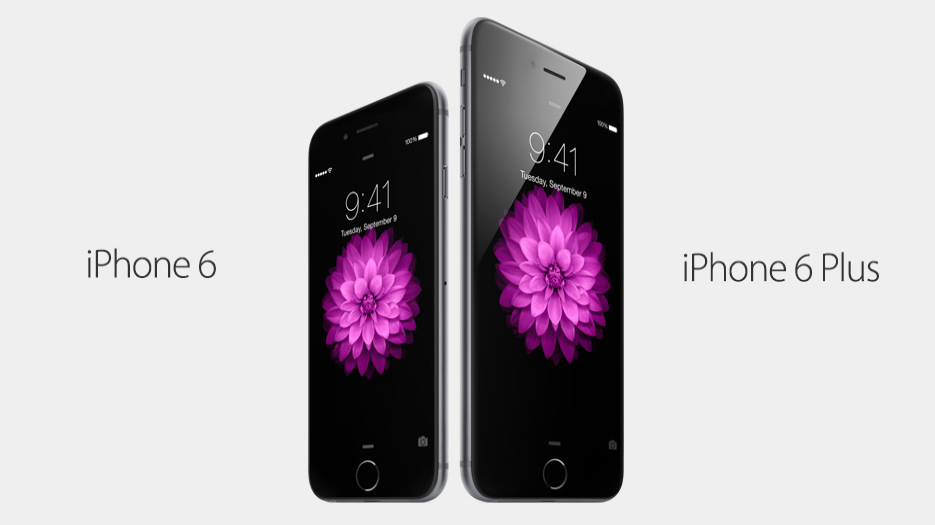As rumoured Apple has announced two new iPhones, in different sizes. The iPhone 6 has a 4.7-inch Retina HD display, while the iPhone 6 Plus is a whopping 5.5-inches taking on all-comers, including the recently launched Samsung Galaxy Note 4.
Unveiled during the company's 9 September press event in Cupertino, the new phones are 6.9mm and 7.1mm thin respectively. In comparison, the iPhone 5S is 7.6mm thick. They have Ion-strengthened glass front panels and resolutions are 1334 x 750 (326ppi) for the iPhone 6, 1920 x 1080 (401ppi) for the iPhone 6 Plus.
The design aesthetic of the phones is very similar to the many leaks we've had of late. The front glass curves around the side on both, the rear is anodised aluminium and the Apple logo is made of stainless steel.
Both devices use a new A8 processor inside, which Apple claims is 25 per cent faster in cpu tasks, 50 per cent faster for graphics. It is also 50 per cent more efficient, so should have an effect on battery life. Apple claims that the larger phone will last 24 hours of 3G talk time, the smaller 14.
The iPhone will also last 50 hours of audio playback, with the iPhone 6 Plus claiming 80 hours. They will last, it is said, 11 and 12 hours respectively for Wi-Fi browsing, 10 and 12 for 4G.
An M8 motion coprocessor is on board for fitness applications. It can measure relative elevation through an included barometer, distance and can even tell the difference between actions, such as cycling and running. Nike will update its Nike+ app to include much of that information, specifically elevation.
As the iPhone 6 Plus has a significantly larger screen - not a million miles away from the iPad mini, some applications and user interface functions have more room to play with and can show more information on screen, rather than just expand the conventional elements.
It can also be used in landscape mode, which makes the UI look more like something you find on a tablet. Even the homescreen adds new buttons when horizontal.
Another small but significant change is that the on/off button has been moved to the side.
An even more significant addition is NFC for contactless payments through a new software feature called Apple Pay. Credit and payment card details are stored in PassBook and you'll be able to use with contactless payment retailers. However, it will be available in the US only initially.
Naturally, both of the new iPhones are 4G LTE devices, with Apple claiming that they support up to 20 LTE bands around the world. They also support VoLTE (voice over LTE) to improve call quality. And Wi-Fi has been improved to 802.11ac for faster and more stable connection.
In camera terms, both phones have an 8-megapixel rear-facing camera, with a True Tone flash and f/2.2 aperture. A next-gen iSight sensor has been added with a new technology called "focus pixels", which can perform phase detection autofocus and hit their mark quicker than before.
Face detection and smile detection is faster too. And there is digital image stabilisation on the iPhone 6. The iPhone 6 Plus has optical image stabilisation. Both can record video in 1080p at 30 or 60fps, and slow motion video can now be shot in 120 and 240fps - twice as much as on the iPhone 5S.
Like many other brands, Apple is focusing (no pun intended) on selfies for its front-facing cameras. Again they feature a new sensor and f/2.2 aperture, but are capable of letting in 81 per cent more light. You can also have HDR selfies now, burst selfies, and it comes with improved face detection on the front snapper.
The iPhone 6 comes in gold, silver or space grey, and will be available in the UK for £539 for the 16GB model, £619 for the 64GB model and, for the first time, a new 128GB model for £699.
The iPhone 6 Plus comes in gold, silver or space grey, and will be available in the UK for £619 for the 16GB model, £699 for the 64GB model and £789 for the new 128GB model.
They will all be available from 19 September with pre-orders starting on 12 September, this coming Friday.

